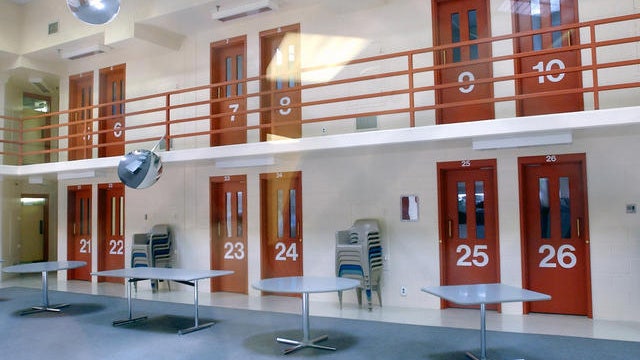Should officers use pepper spray in prisons?
Jessica Tarlov and Liz Peek on whether politicians should have a say in program
WASHINGTON – It was an eight-minute assault -- and would take another 30 minutes before prison officials at the U.S. Penitentiary at Canaan, Pa., would find Eric Williams’ battered body. The 34-year-old corrections officer, in an ambush, had been stabbed 129 times.
Reports would say inmate gang member Jessie Con-ui knocked Williams down a staircase, fracturing his skull and stabbing him repeatedly. When authorities found Williams’ body, he had only a set of keys, a pair of handcuffs and a hand-held radio on him – but to defend himself.
“I was appalled,” Don Williams, Eric’s father, told FoxNews.com. “He was working alone, was unarmed and was working in a housing unit with 125 high-security inmates.”
Williams' death, two years ago, helped fuel a major shift in U.S. prisons, which now are letting many guards at least carry pepper spray to defend themselves.
The program, however, remains controversial, and some on Capitol Hill are pushing to make it permanent -- just in case the Bureau of Prisons has a change of heart.
“To leave these men and women unarmed and alone – there’s no rationale for it,” Williams said.
'A second officer with pepper spray … my son might be here'
Williams says his son’s death should serve as a warning for what could reoccur if corrections officers aren’t given the tools needed to defend themselves on the job.
Sen. Bob Casey, D-Pa., was behind the successful push to launch a pilot program providing pepper spray to recreational, food service and other employees working at high-security federal prisons. The program, run by the Bureau of Prisons, was recently expanded to medium-security facilities.
Casey wants it broadened even more and made permanent, and has a bill in Congress that would achieve that. He calls the pilot program a "step in the right direction."
Critics, though, warn that armed guards run the risk of being overpowered by their own weapons. They also claim giving correction officers pepper spray and similar self-defense equipment could lead to prisoner abuse by the guards.
It’s an argument Williams says doesn’t resonate with him. “It’s the same thing as telling a police officer that he shouldn’t have a weapon because the bad guy can take it off you,” he said.
Ironically, security guards at malls and office buildings across the country have more self-defense tools at their disposal than most correction officers guarding dangerous criminals.
Since its more than 100-year history, 26 federal correction officers have been killed while on duty—but hundreds more have been injured in attacks, according to the American Federation of Government Employees, the union that represents many federal prison employees.
In 2008, Jose Rivera, an Iraq war veteran, took a job at the high-security federal prison in Atwater, Calif. He had been at his post for 10 months when he was attacked by two convicted murderers serving life sentences.
It happened when Rivera, who was alone and guarding 100 inmates, tried to get prisoners Joseph Cabrera-Sablan and James Leon Guerrero back into their cells. They turned on him. Outnumbered, he tried to escape, but tripped. Rivera didn’t have a baton, pepper spray or a protective vest.
When officials found him, he had been stabbed with makeshift knives and died later that night at a hospital. He was 22.
“The pepper spray resource has long been an ask of the AFGE,” John Rizzo, a spokesman for Casey, told FoxNews.com. He added that the initiative has taken “longer than we would have liked” to make its way through congested congressional channels but said the senator had found a “welcome reception” for the expansion.
Rizzo says while there have been anecdotal stories about guards using chairs to subdue inmates in the past, “sadly almost nothing” has been done on a federal level to arm prison officers permanently.
In June 2012, the 1,817-inmate prison at Lewisburg federal penitentiary in Pennsylvania became the first to give its guards pepper spray. Based on its success – which showed a steady drop in assaults on prison staff -- the BOP announced nine months later that officers in all high-security facilities would be armed with pepper spray.
Before the pilot program for maximum-security prisons in 2012, the BOP had prohibited all correctional officers from carrying pepper spray because prisoners could overpower them and use it on them. Instead, corrections officers are trained to verbally diffuse confrontational situations.
The program is currently authorized for all staff at high- and medium-security federal corrections institutions. The BOP is working with interested institutions and ultimately will determine how many facilities in the country will implement the program.
Casey’s goal is to put the program into law so that the BOP cannot unilaterally rescind it. That means, if it’s on the record books as law, a warden or other prison official will not be able to come in and reverse it.
The latest push to arm officers also opens up dialogue on other issues plaguing the federal prison system -- specifically, overcrowding. According to the bureau's “The Federal Prison Population Buildup: Overview, Policy Changes, Issues and Options,” the official inmate-to-correctional officer ratio in the federal system is 9.9 to 1.
At the state level, the ratio of inmates to correctional officers for all state agencies was 6.2 to 1.
Despite the seemingly low ratio, corrections officers and others with a working knowledge of the system tell FoxNews.com that the numbers just don’t add up. For example, in the cases of Rivera and Williams, each officer was guarding more than 100 inmates each.
“The numbers are misleading,” Williams said.
“I thought about it a lot,” Williams said. “Eric was ambushed from behind and knifed. But certainly… a second officer with pepper spray … my son might be here."






















